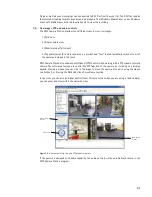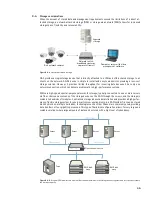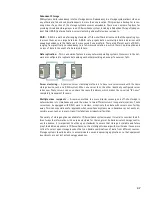
47
Redundant Storage
SAN systems build redundancy into the storage device. Redundancy in a storage system allows video, or
any other data, to be saved simultaneously in more than one location. This provides a backup for recov-
ering video if a portion of the storage system becomes unreadable. There are a number of options for
providing this added storage layer in an IP-Surveillance system, including a Redundant Array of Indepen-
dent Disks (RAID), data replication, server clustering and multiple video recipients.
RAID
-- RAID is a method of arranging standard, off-the-shelf hard drives such that the operating sys-
tem sees them as one large hard disk. A RAID set up spans data over multiple hard disk drives with
enough redundancy so that data can be recovered if one disk fails. There are different levels of RAID -
ranging from practically no redundancy to a full-mirrored solution in which there is no disruption and
no loss of data in the event of a hard disk failure.
Data replication
-- This is a common feature in many network operating systems. File servers in the net-
work are configured to replicate data among each other providing a back up if one server fails.
Server clustering
-- A common server clustering method is to have two servers work with the same
storage device, such as a RAID system. When one server fails, the other identically configured server
takes over. These servers can even share the same IP address, which makes the so-called “fail-over”
completely transparent for users.
Multiple video recipients
-- A common method to ensure disaster recovery and off-site storage in
network video is to simultaneously send the video to two different servers in separate locations. These
servers can be equipped with RAID, work in clusters, or replicate their data with servers even further
away. This is an especially useful approach when surveillance systems are in hazardous or not easily ac-
cessible areas, such as in mass-transit installations or industrial facilities.
The variety of storage options available for IP-Surveillance systems makes it crucial to consider the dif-
ferent ways the information will be used and stored for the long term. As hard drive technology contin-
ues to advance, it is important to utilize open standards to ensure that storage is scalable and future
proof. In addition, advances in IP-Surveillance, such as intelligent video algorithm, will make it even more
critical to select open storage devices that can handle combinations of data from different sources.
Storage systems should be able to accommodate new and upcoming applications so that equipment
investments are not lost as technology advances.
Содержание IP-Surveillance system
Страница 49: ...49 ...




































